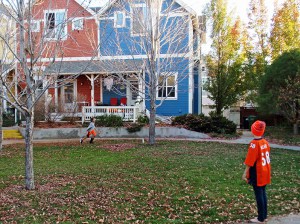SLOAN LAKE — For many years, I have walked around Sloan’s Lake three or four times a week, in all kinds of weather, and at all hours of the day and night. I’m usually lost in my own world, listening to Shakira on my iPod, or walking with to my best friend at 5am, engrossed in our conversations about life and love and our children. This summer, we started to notice that tents were set up along the perimeter of the lake… but it didn’t merit much more than a passing comment: we are both very busy and we have so much to talk about when we see each other that we don’t usually notice what is going on around us. Then this fall my friend got too busy to walk much, and I lost my iPod, so I began to notice more.
First I noticed that the brush had been cut around the lake and that all of the tents had disappeared. Except one. There was one tent, near the bridge off Sheridan, that was there day after day. The man and woman who lived there were often sitting outside, and I felt like I was walking through their yard, so we started to say hello. Then November came, and as I talked to my students and my own children about all of the blessings in our lives, I realized that I knew nothing about these people who I greeted every day, and what led them to be living in a park. So I began to bring them food, (Tamale Kitchen is their favorite!), and the conversation began.
At first, we talked about how the lights from the businesses on Sheridan look like Christmas lights. Todd and Kim, it turns out, are very positive. Then one day, I asked how it was that their tent was still up when everyone else had left. Todd shared that he was a Lieutenant, and had done two tours of duty in Afghanistan, so the police officers respect him and usually leave him alone. And their story began to unfold.
Todd is a caretaker of all of the people that live in his corner of the park, some of whom have lived at Sloan’s Lake for years. He and Kim, who are not a couple, came to live together in the most tragic of ways. Todd was good friends with Kim’s husband Joe, who was also a veteran. Joe had a spinal injury he sustained in the Vietnam War and confined to a wheelchair. Todd tells me that when Joe would fall asleep at night, all of his worldly possessions would fall out of his chair, and so Todd would pick them up for him and make sure that he kept everything together. As he tells it, Joe and Kim were always together, until a month ago when Kim had to spend some time in jail for vagrancy. When she was gone, Joe was fatally shot in a fight and pushed into the lake. When Kim got out, she was inconsolable. “She was lost and needed somebody and had nowhere else to go, so I take care of her,” said Todd.
Todd and others who I have met at their tent, have such tenderness for Kim that it gives me faith in the human spirit. “She’s grieving hard and I don’t know what to do for her,” he says. He knows something about grief. Todd had a full life as a fly-fishing and elk hunting guide outside of Glenwood Springs. He had a wife and two children. But memories of losing troops in Afghanistan haunted him constantly, and then a year ago, his mother and two sisters were killed in a car accident. “I got really depressed and started drinking,” he said. “I could get help, but I’m too proud. I’m trying to handle this on my own.”
Todd and Kim say that many people come by and offer food or blankets. “We call them angels,” she says. Others ignore them or treat them “like lowlifes.” Life in the park is very dangerous, “sometimes more dangerous than Afghanistan.” People get in fights; they get shot, and they are continually worried about their possessions being stolen. Todd tells me about a friend of his named Dreamer, who is Lakota. He was a staff sergeant serving in Iraq, and they bonded over this. Todd worries because Dreamer disappears for days. He also says that he knows he can “get it together.” He longs for a normal life again.
I walked by yesterday, and the tent was gone. I hope that Todd and Kim are safe and warm. They knew where the shelters are located, but preferred to be in the park. I’ll look for them again in the morning, and from now on I will keep my eyes open. How did I not notice that there was someone living in a wheelchair at Sloan’s Lake? How many times did I walk past him over the years? So often we don’t see, or we avoid looking. It’s raw. It’s uncomfortable. But when we do take the time, it can be inspiring.
By: Morgain Sanchez
The post Noticing the people living at Sloan’s Lake appeared first on North Denver Tribune.
